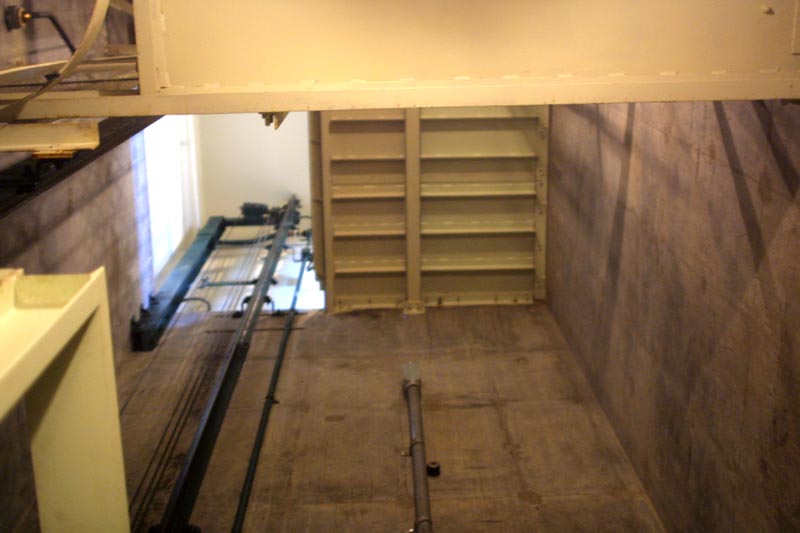
|
A look up through the open elevator, as we
begin our descent. The shaft is ten feet square, and the elevator itself
moves rather slowly.
|
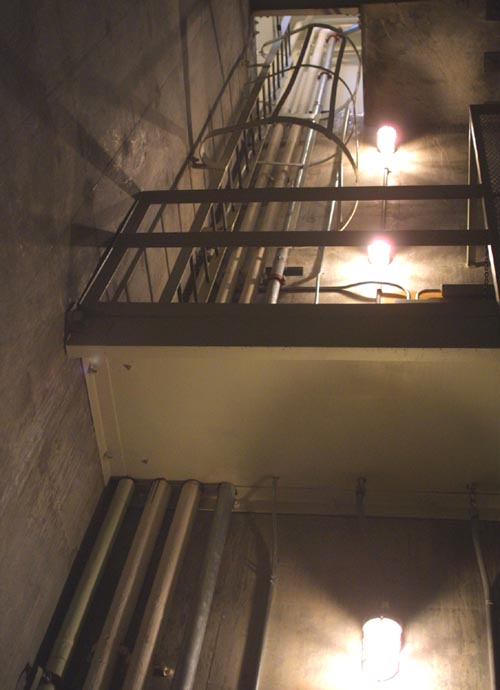
|
The ladder coming down, complete with safety
cage, is set off in ten feet stages, so that a slip will not cause a fall
all the way to the bottom. Still, a fall of ten feet onto concrete is not
a pleasant experience. Military installations are not designed to deal lightly
with the foolish, careless, or inattentive.
|
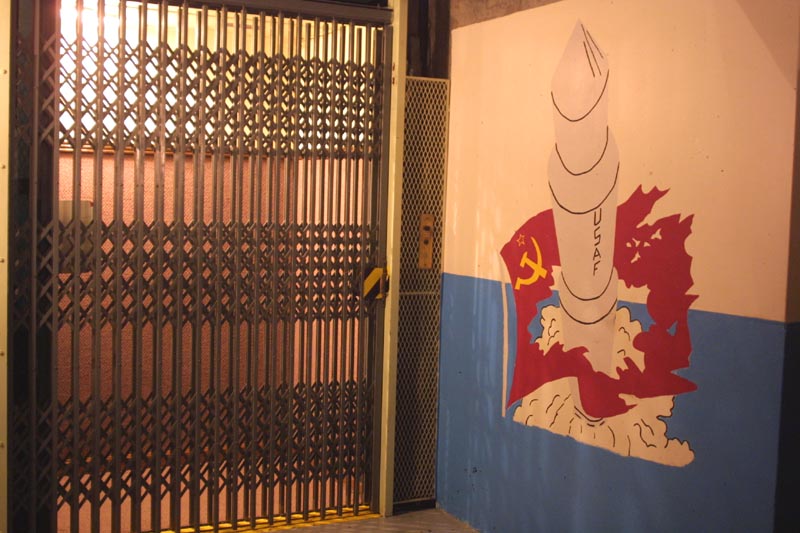
|
The elevator rests at the bottom of the shaft.
Many of these areas were decorated by the personnel serving in them. This
was a very human attempt to impose some warmth on the stark, gray squared
off world of the underground LCC.
|
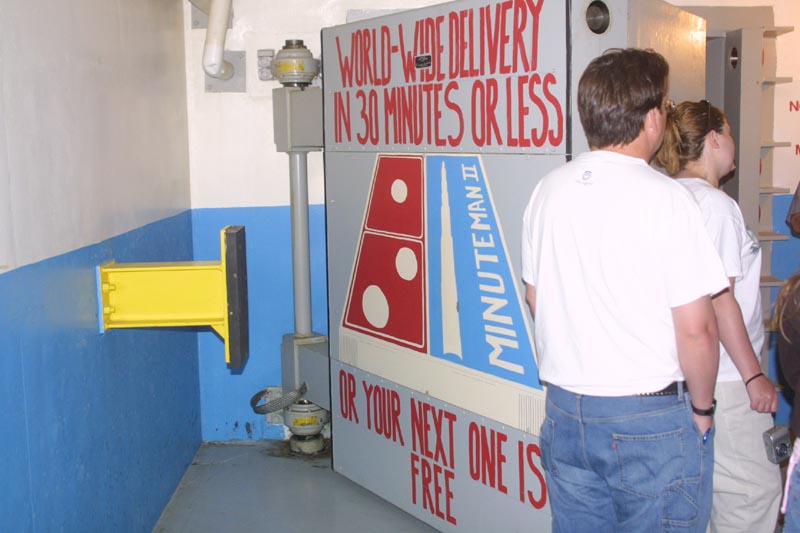
|
Behind this eight ton blast door, sits a capsule
with controls for launching the deadliest weapon know to man. The door is
steel and concrete, and is four feet thick. The yellow girder to the left
of the photo is a door stop, to halt the swinging of the heavy door, once
it is opened.
|
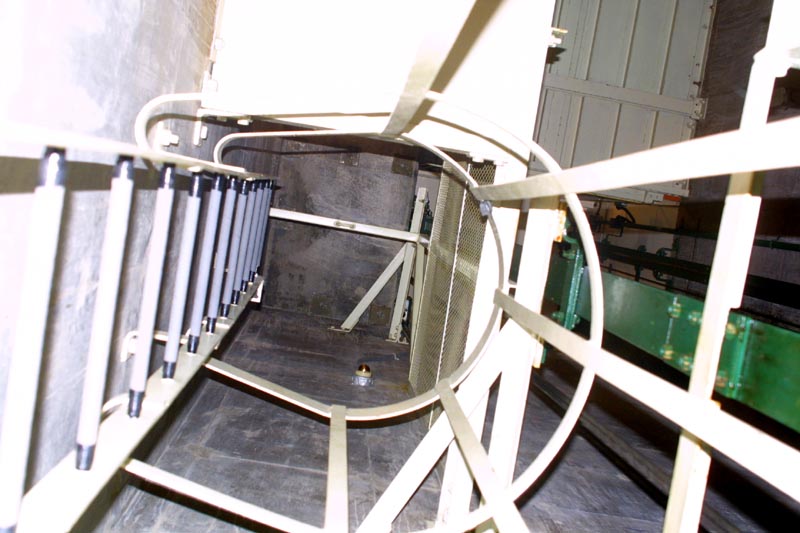
|
A look up the ladder to the top of the lowest
stage. The elevator shaft is to the right of the photo.
|
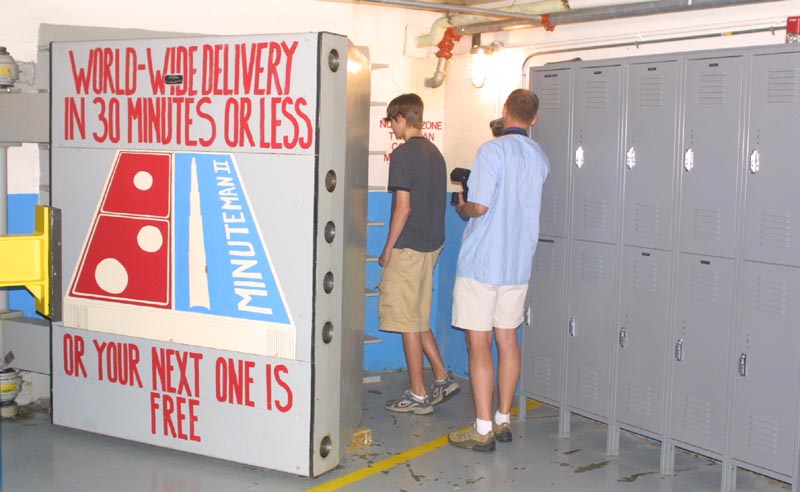
|
A group of tourists enters what had once been
one of the most secure, and restricted spaces in the world. On the blast
door can be seen another example of artwork. Reference is made here to the
promise by Domino Pizza, that a pizza delivered more than a half hour after
being ordered is free. It is also a reference to the fact that, at 15000
mph, a Minuteman would be in the old Soviet Union within 30 minutes. Also
notable, is the fact that, unlike the vault door in a bank, there is no way
to open this door from the outside.
|
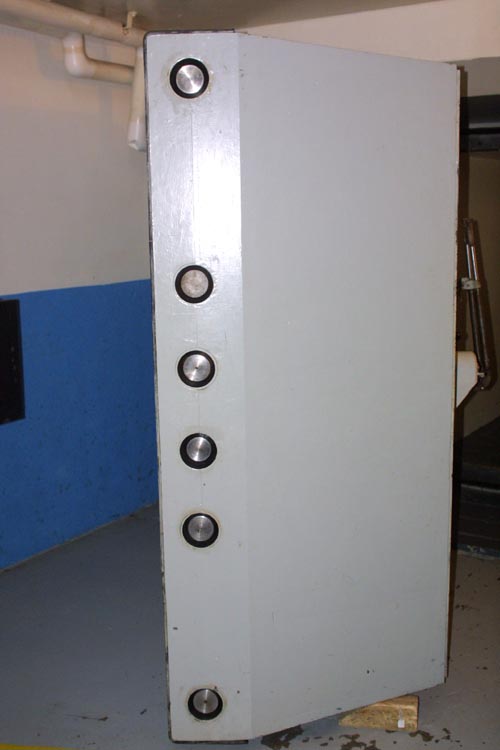
|
A side view of the door, shows it's four foot
thickness. These doors were designed, not only to defeat attempts at unauthorized
entry, but also to protect the capsule in the event of a nuclear detonation.
The locking bars, in the side of the door, mated with a set of openings in
the steel door frame, and were controlled by a set of lever operated hydraulic
pumps, on the inside of the door.
|
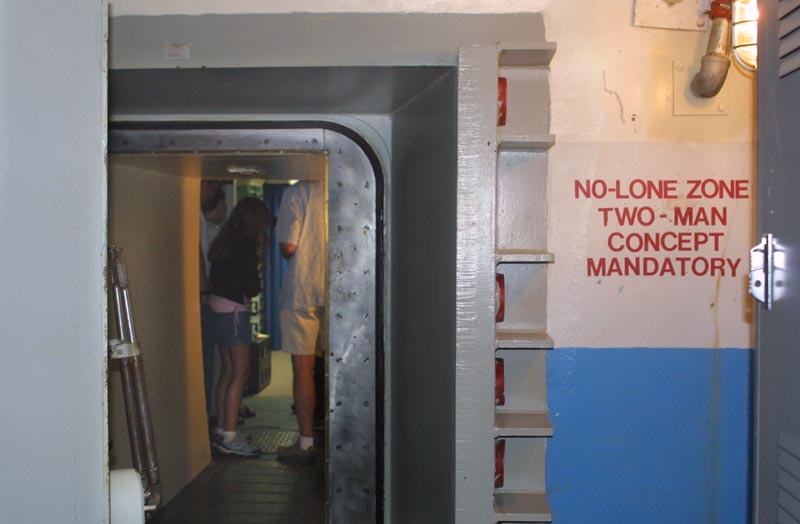
|
A look at the steel door frame within which the
blast door is set. The square opening is essentially a tunnel in the thick
concrete wall of the outer capsule. It does not offer full headroom, requiring
a bit of a stooped walk during passage.
Note the reference to the "No-lone Zone". There could never be only one
person in the capsule at a time. Each member of the team assigned to man
these capsules was required to keep his partner in view at all times. This
impractical rule was often ignored, since team members did nap on the 24 hour
shifts.
|
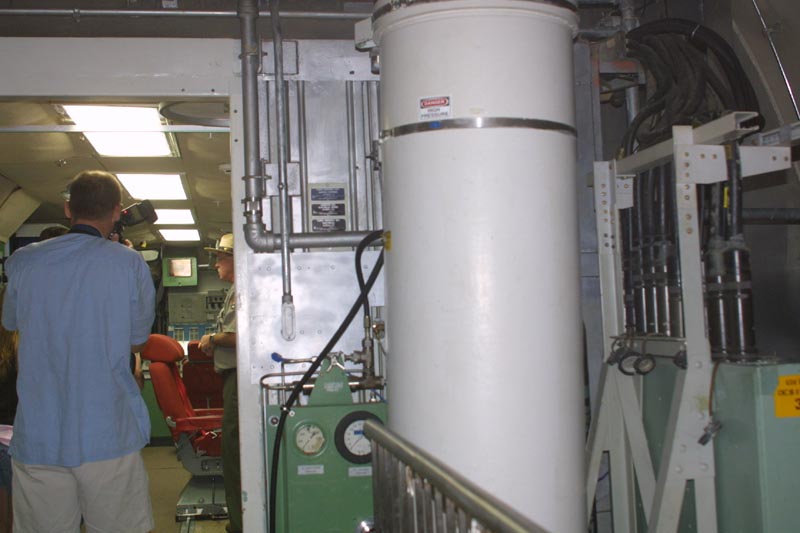
|
The low passageway opens up into the interior
of the concrete outer casing. The outer casing is twenty-nine feet in diameter
and fifty-four feet in length (outside dimensions). This outer capsule
was essentially a reinforced concrete egg, four feet thick, and lined with
steel plate. This photo was taken in the outer casing, looking towards
the doorway to the rectangular, steel inner capsule, which houses the missile
controllers, communications gear, monitoring equipment, and the two officers
by which it is all operated. The steel rail, to the right, is a handrail.
Once through the low passageway, and inside the outer casing, a small bridge
crosses to the crew capsule.
|
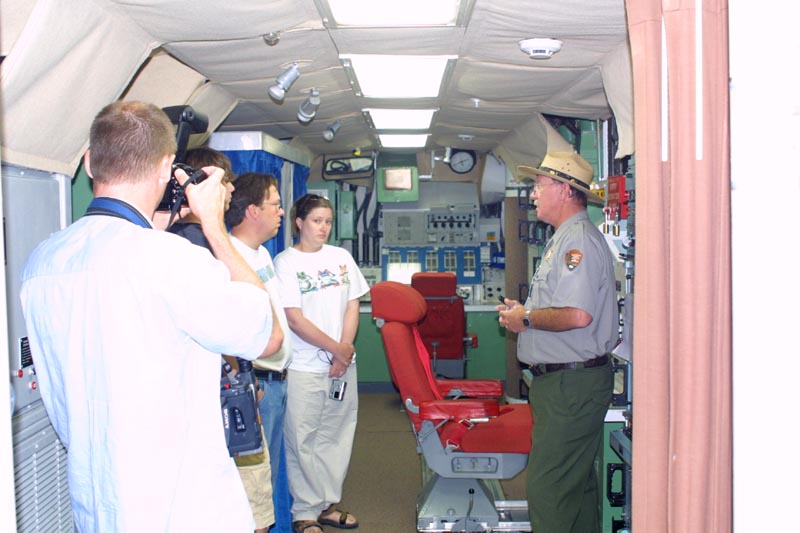
|
A look inside of the capsule. The space is
rectangular, and measures 12 by 28 feet. It does not rest on the floor
of the outer casing. Instead, it rests on a 12 by 32 foot steel platform,
which is suspended from the ceiling of the outer casing. The chains, by
which this capsule is suspended incorporate shock isolators, which permit
the capsule to bounce two feet without structural or equipment damage. To
this end, note the seat belts on the chairs. These seats were of the same
design as those used in cold war bombers. The blue curtained structure to
the left is a bed, which can be closed off from the rest of the capsule for
a nap.
|
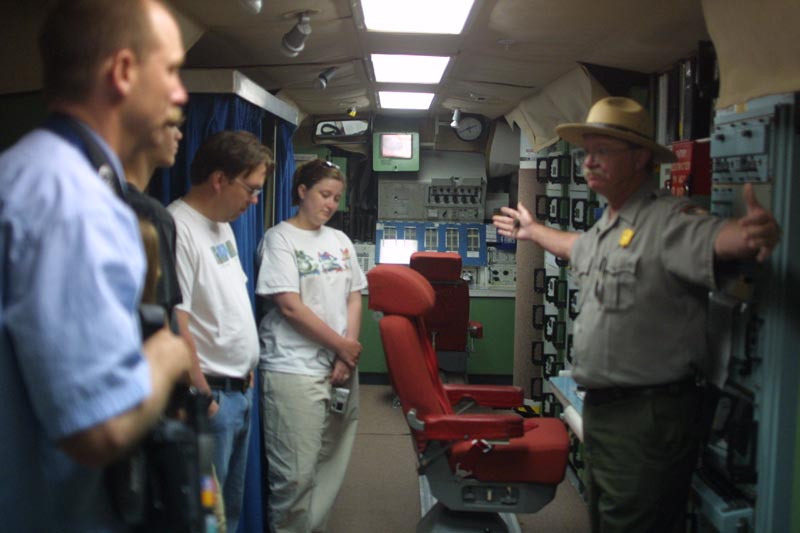
|
Our guide inviting us to engage in a group
hug. Just kidding, actually he was trying to illustrate a point.
We are inside of the capsule, and listening to our guide describe his experiences,
and relay information about the function and purpose of these facilities.
Having worked in these capsules himself, as an Air Force officer, he had
many interesting, as well as a few humorous, stories to tell. Underneath
the removable steel floor panels are batteries which, according to our guide,
could sometimes overheat and explode.
|
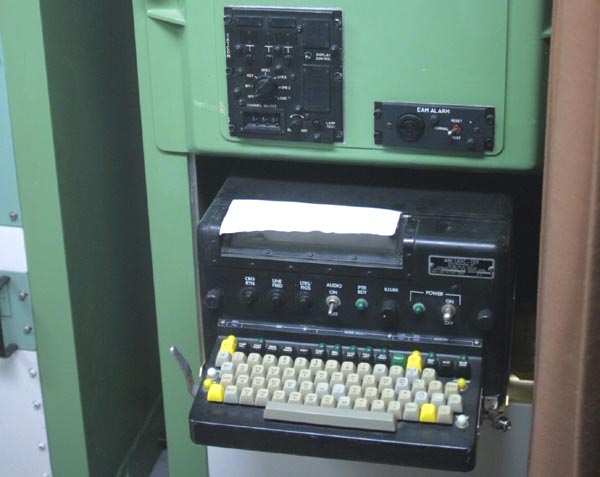
|
AFSATCOM is a satellite based system that provides
high priority communications for command and control of American global nuclear
forces. It became operational on May 19, 1979. served Air Force strategic
aircraft, airborne command posts, and ground terminals.
AFSATCOM uses a mix of UHF and X-band frequencies with anti jamming protection
for most of its uplinks by frequency hopping (rapid switching of frequencies
during transmission).
|
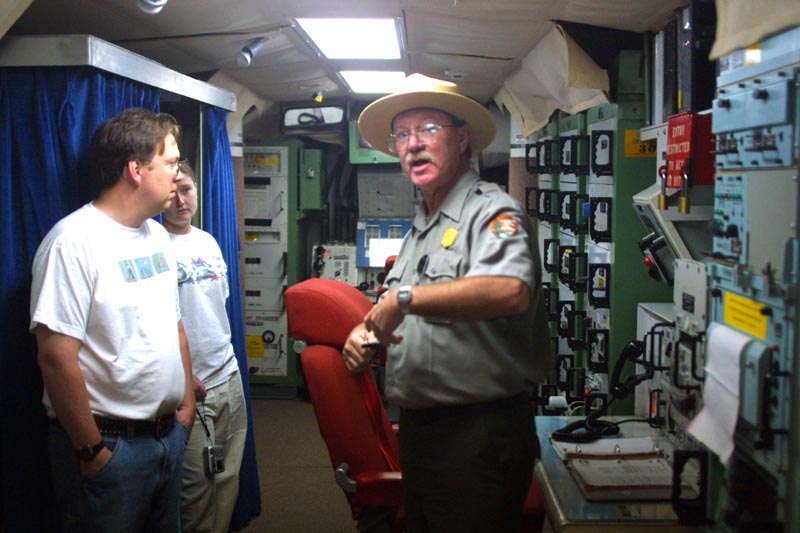
|
Our guide in what are, to him, familiar surroundings.
The constricted space is filled with machinery. Every piece of gear in the
racks has handles for quick replacement. To minimize downtime, nothing down
here was repaired at the site. There were spares for everything. If a unit
went down, a spare was brought and installed in a few minutes.
|
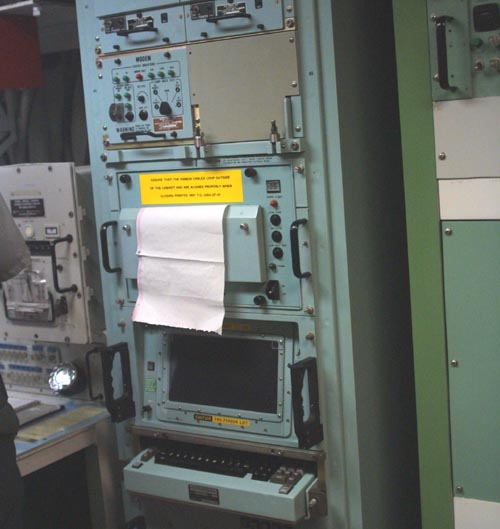 This is SACDIN, Strategic Air Command Digital (Information) Network,
which is the data transmission segment for directing SAC's strategic forces.
After formal acceptance, it became known as SACCS. The system distributes
and stores data of any level of security classification. The sophistication
of access nodes is dependent on the location. The security monitor is controlled
by the internal access control mechanism, which resides in PROM. Details
of the access process are provided, including message flow on trusted paths
appropriate to the security clearance of the user. The Strategic Automated
Command Control System [SACCS] network is the primary network for the transmission
of Emergency Action Messages (EAMs) to the commanders in the field. It is
the prime communications link between the CINC USSTRATCOM and their nuclear
missile forces, as well as to other forces world-wide. SACCS is located
in the CINCSTRAT command post, strategic command centers, missile launch
control centers, launch control facilities, and at strategic aircraft sites.
The system was initially fielded in 1963 and was updated by SACDIN in 1988.
The SACCS Data Transmission Subsystem provides primary command and control
capability for receiving and transmitting secure EAMs, Force Direction Messages.
Special emphasis was placed on SACDIN's ability to maintain an end-to-end
message delivery time of not more than 15 seconds for Emergency Action Messages.SACCS
is operationally capable of providing full-duplex, secure data communications
over any level of projected message activity.
This is SACDIN, Strategic Air Command Digital (Information) Network,
which is the data transmission segment for directing SAC's strategic forces.
After formal acceptance, it became known as SACCS. The system distributes
and stores data of any level of security classification. The sophistication
of access nodes is dependent on the location. The security monitor is controlled
by the internal access control mechanism, which resides in PROM. Details
of the access process are provided, including message flow on trusted paths
appropriate to the security clearance of the user. The Strategic Automated
Command Control System [SACCS] network is the primary network for the transmission
of Emergency Action Messages (EAMs) to the commanders in the field. It is
the prime communications link between the CINC USSTRATCOM and their nuclear
missile forces, as well as to other forces world-wide. SACCS is located
in the CINCSTRAT command post, strategic command centers, missile launch
control centers, launch control facilities, and at strategic aircraft sites.
The system was initially fielded in 1963 and was updated by SACDIN in 1988.
The SACCS Data Transmission Subsystem provides primary command and control
capability for receiving and transmitting secure EAMs, Force Direction Messages.
Special emphasis was placed on SACDIN's ability to maintain an end-to-end
message delivery time of not more than 15 seconds for Emergency Action Messages.SACCS
is operationally capable of providing full-duplex, secure data communications
over any level of projected message activity.
|
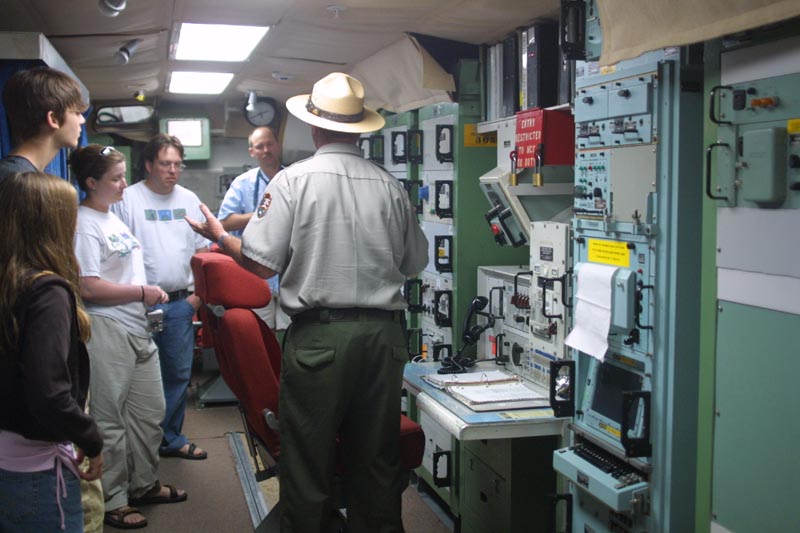
|
Our guide stands by the deputy commander's
console, and explains the workings of some of the equipment. To the right
of the deputy commander's station is the SACDIN, and to the right of this
is the receiver for the SLFCS (See below)
|
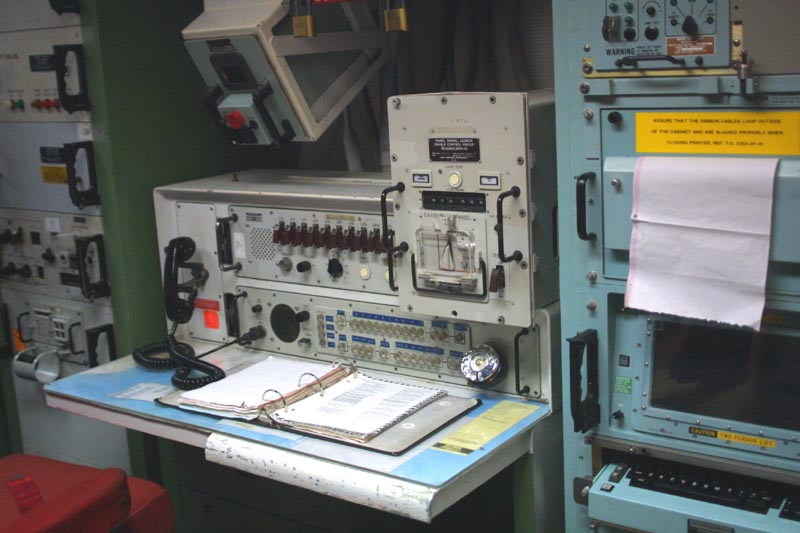
|
This is the deputy commander's station. The
gray rack to the right, with the handles, is the deputy commander's launch
controller. The main job of the deputy commander seems to be one of communication.
|
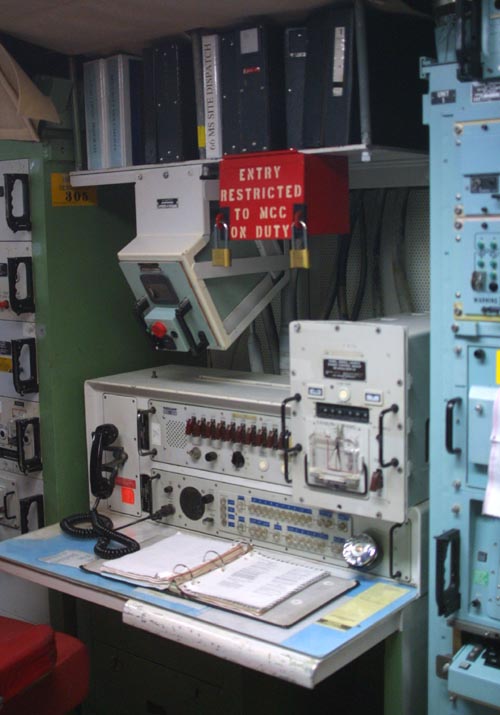 The unit above the console, with the red button, is the head for the
Survivable Low Frequency Communications System. This is a low rate communication
system. It uses the Very Low Frequency/Low Frequency (VLF/LF) (14-60kHz)
portion of the spectrum for Minuteman and Peacekeeper LCCs in both normal
and in nuclear and/or jammed environments. SLFCS was developed in the 1960’s
and called 487L. In the 1970’s an upgrade was added and called 616A. Because
it operates in the VLF/LF bands and uses a buried antenna, SLFCS is a survivable
system. However the extremely slow speed of message reception in this band
means that it cannot be considered a timely system. In addition, its lack
of a transmit capability means that it is not useable for force report-back
messages.
The unit above the console, with the red button, is the head for the
Survivable Low Frequency Communications System. This is a low rate communication
system. It uses the Very Low Frequency/Low Frequency (VLF/LF) (14-60kHz)
portion of the spectrum for Minuteman and Peacekeeper LCCs in both normal
and in nuclear and/or jammed environments. SLFCS was developed in the 1960’s
and called 487L. In the 1970’s an upgrade was added and called 616A. Because
it operates in the VLF/LF bands and uses a buried antenna, SLFCS is a survivable
system. However the extremely slow speed of message reception in this band
means that it cannot be considered a timely system. In addition, its lack
of a transmit capability means that it is not useable for force report-back
messages.
The red box next to the SLFCS, is the safe. It is where the codes are
kept, and also where the extra ammunition for the revolvers arming the launch
officers is kept. It is secured by two padlocks; each launch control officer
has the combination to one.
On the shelf above are procedures, operating manuals, and codes.
|

|
This is a close up of the commander's station.
Directly in front of him are status indicators for the ten missiles of
his flight. The plastic faced upper panel is designed for the use of grease
mark pencil. Below is a communications console, and to the right is the
launch control section. The primary function of the commander is to monitor
the missiles.
|
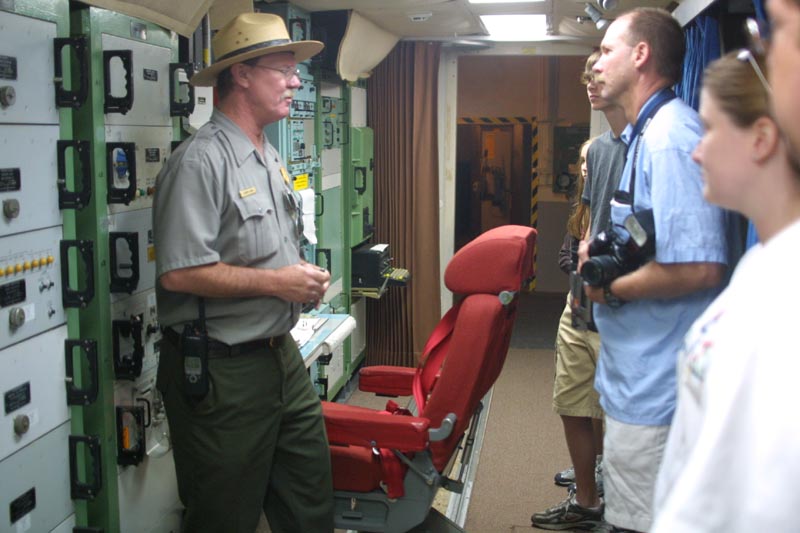
|
During operation, the entire interior reverberated
with the hum of machinery, the high pitched whine of electronics, and the
dull rush of forced air. Launch officers reported that their ears would
sometimes ring for hours after finishing a shift. This is a photo looking
towards the exit of the capsule. The yellow and black striping on the door
frame, warn of limited access.
|
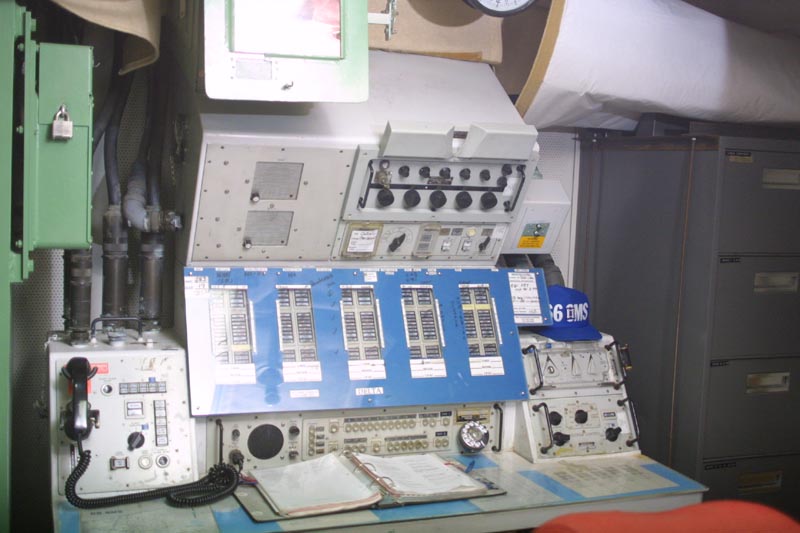
|
The commander's station. Note the mirror towards
the top of the photo. This is so that the commander can always keep the
deputy commander in view.
|
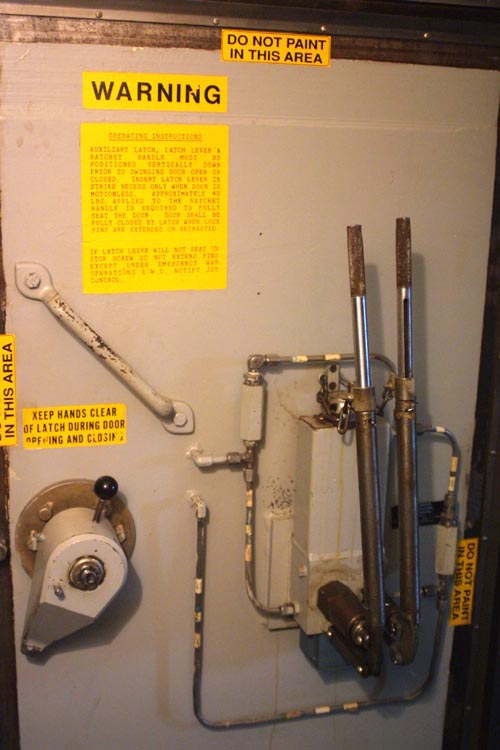
|
The inside of the blast door. This door weighs
eight tons, and can develop quite a bit of force, even if it is moving
slowly, which is the reason for all of the warning stickers. The two handles
are used to pump up the hydraulic system, which unbolts the door.
|
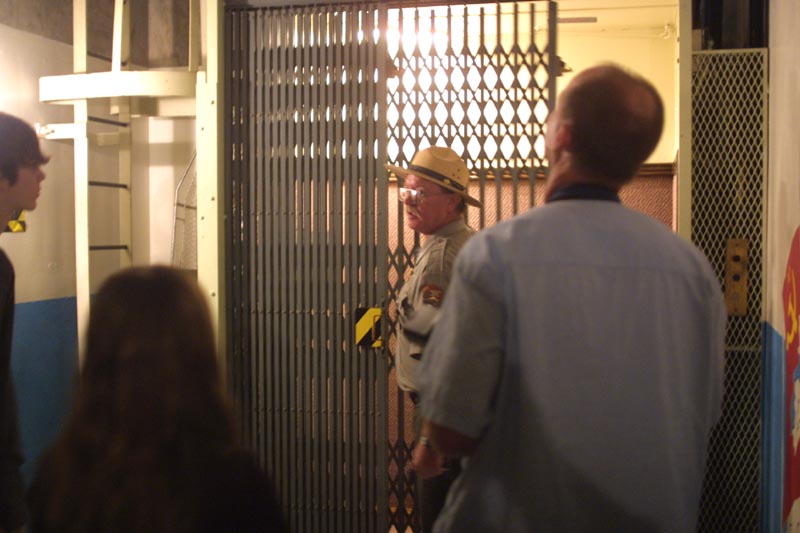
|
Having looked over the underground LCC, we
are heading back to the surface.
|